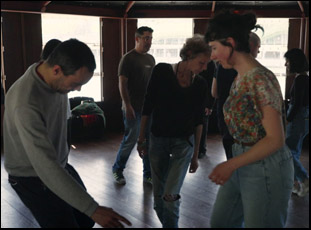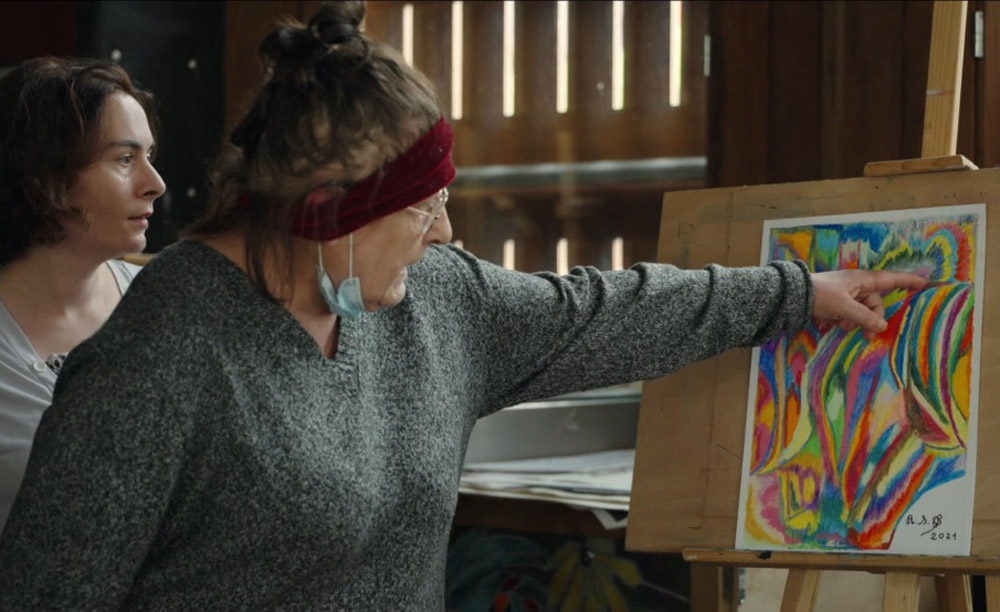Throughout his career, Nicolas Philibert has known how to navigate sensitive spaces, often quietly in awe of those who themselves have had to work a little harder to find their way through the world due to extenuating circumstances, whether it was those without the ability to hear that he profiled in his 1992 film “In the Land of the Deaf” or the children in his landmark 2002 feature “To Be or To Have” who gathered into a one-room school on the outskirts of France for their education. It is a bit of a jolt then to see this breakthrough happen immediately in “On the Adamant,” which takes places in a most unusual psychiatric center designed as a boat docked on the Seine River in Paris where one of its passengers Francois can be seen making waves with a glorious rendition of Téléphone’s “The Human Bomb.”
Art becomes a primary form of expression for those who board the Adamant, a brainchild of Linda de Zitter, a psychologist who the director had known from the production of his 1996 film “Every Little Thing” where a play brought out the personalities at another clinic she worked at. Their behind-the-scenes reunion 25 years later sets the stage for a gentle and deeply moving look at a collection of neurodivergent people whose creativity is activated by the prospect of an empty canvas or a piano to play. Philibert settled in for seven months on the ship to get to know a few on board, such as Frederic, who admits “science fiction, comics and pop music have helped me stay alive,” and Catherine whose passion for dance is limited by her mind rather than her body. It is also the tenth anniversary of the Traveling Workshop, the Adamant’s ongoing film festival (for which Philibert was once invited as a guest speaker), and when Francois Truffaut’s metafictional “Day for Night” is selected by a passenger to play, one can’t help but think of the variety of ways in which people have found alternatives to direct conversation to process their experience in ways that words fail over time.
Philibert has already committed to taking a long view to this kind of therapy, not only with “Every Little Thing” and now “On the Adamant” as potent observations of its efficacy, but with two additional features in the works and as “On the Adamant” reaches U.S. shores after being hailed at last year’s Berlinale where the director was awarded the Golden Bear for Best Film, he graciously spoke with the help of an interpreter about how he was drawn to filming on the Adamant, remaining open to the experience unfolding in front of him and how the film unexpectedly became the start of a series for him.

I’ve known about this place for a long time now, and I always knew that it was a particularly lively, inventive place, a very open place and a place where there’s a great deal going on. Guests are regularly welcomed aboard the Adamant — writers, filmmakers — and a painter will come and talk about his work. It’s a place that’s open to the world and where trips to the theater, the museum, and hikes in the woods are organized, so I always thought that filming this place was potentially very promising.
When I started this project, I decided that I would do it in a way where I let myself be carried by the everyday life of this place. I often say that I made this film by surrendering to chance. I didn’t come to the boat with a schedule or a worked out idea of what I was going to do. I came with the desire to meet the passengers, to get to know them, and to invent the film day by day with no official discourse on psychiatry. I came wanting to be in harmony with the place.

I don’t have interviews in my films. I’m not a journalist. Sometimes we talk. A passenger may say something to me while I’m filming or ask me a question while when I’m filming and I’m someone who answers when he’s spoken to, but I don’t say to people, don’t look at the camera. In my films, people can look at or into the camera and they can talk to me. And in fact, these moments express the relationship that we had on the shoot. Of course, the workshops in music and drawing say a lot about these people, about their aptitudes, their talents, and their personalities. They’re those who write songs, those who draw, and some of them are deeply cultured or have real artistic talent. They’re all hypersensitive people, which makes them very moving and attractive.
That opening scene with Francois is just sensational. Did you know in the moment that him singing might make a great introduction for the film or was that was something you realized later in the editing room?
It’s true that when I filmed this moment when François sings this song, I found it so strong and in such resonance with the world of psychiatry that I immediately thought that it could be an opening scene. But we still had to get the rights [to the song]. We had to negotiate with the record company, the publishers and with the musicians, but we succeeded. What was very overwhelming was when I said to François, “Here, François, we are trying to get the rights for this song to be able to put it in the film,” and we made a copy of the scene and sent it to the musicians of Telefon. And when François learned that his musicians, who are like idols to him, saw him sing their song, he was extremely moved and very proud.

I have the feeling that you always have to adapt, even if the experience of “Every Little Thing” taught me a lot. You have to be flexible and able to adapt to each new situation because you are always faced with new people. And when you make a film, there is never a recipe for making a film. One must be able to adapt every time. It’s essential.
Was there anything that happened that took this in a direction you didn’t expect?
One of the pleasures I have when making my films is being able to be surprised. If I make films without having built a program beforehand, but by being guided by the daily life of a place like the Adamant, it’s to stay in the pleasure of the unexpected. In the psychiatric environment in particular, you’re often confronted with the unexpected. A person will make a remark or have an attitude that is a bit surprising. You’re often surprised, sometimes even taken aback. But for someone like me who likes to let himself be modified by reality, this dimension is very precious. My films are nourished by the unexpected. When things are too written or too planned out, I get bored. What saves me from boredom is surprise and the accidental.

I prefer to speak of a triptych than of a trilogy, to show the audience that the three films are completely independent. You can see the second without seeing the first, and the next two films were not planned at all. It was while filming on the Adamant that the idea of making two other films came up — one at the hospital, and another in which I accompanied the Adamant’s nurses who visited patients at home when a patient was confronted with a domestic problem [where] something is not working in their homes and a nurse will go and help fix whatever is broken — and over the three films, some of the protagonists will recur. For now, only one of the films has U.S. distribution, but perhaps the second and third parts will, too, and I would say that the three films describe three different aspects of how psychiatric care tries to help patients patiently recreate their link to the world, and of course to themselves.
“On the Adamant” opens on March 29th in New York at the IFC Center, April 18th and 19th at the Cleveland Cinematheque, April 19th in Los Angeles at the Laemmle Royal and May 24th in Chicago at the Gene Siskel Film Center.




